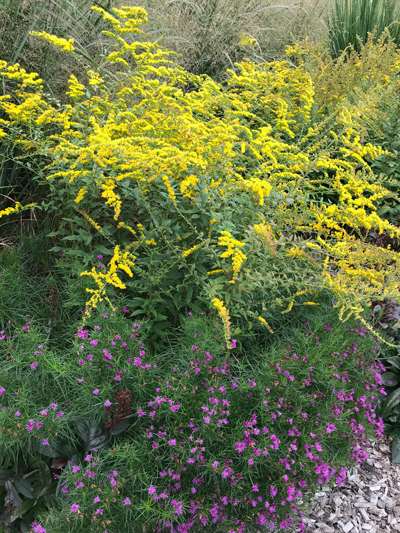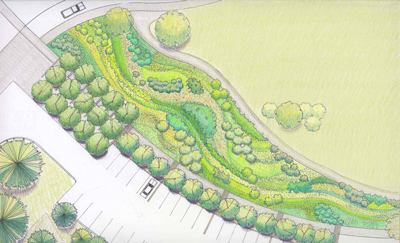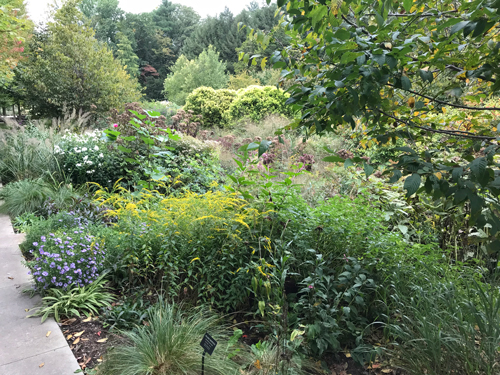by Michelle Sutton

MINI-GLOSSARY OF ESSENTIAL TERMS
Stormwater is the excess water from rain events and melting snow that doesn’t immediately infiltrate soil, but rather flows across the soil surface. Stormwater infrastructure is costly to municipalities, and haphazard stormwater runoff is harmful to ecosystems because of streambank erosion, excessive sedimentation, bacterial and fertilizer contamination of waterways, and more.
Bioswales are strategically located trenches in the earth that are lined with porous materials and plants in order to slow stormwater runoff so that it can infiltrate and be cleaned by the soil. Bioswales and rain gardens are both constructed to slow water movement, but bioswales are designed to handle a specific amount of runoff from a large impervious surface, such as a roadway or parking lot. Plants in bioswales assist with stormwater infiltration and provide ecosystem services like wildlife habitat creation and urban heat island cooling.
Rain gardens tend to be smaller than bioswales and are more commonly used for residential stormwater management. As defined by the Cornell Urban Horticulture Institute, rain gardens are “constructed vegetated depressions used to temporarily retain stormwater runoff from impervious surfaces during storm events typically of one inch or less. Using plants and distinct engineered substrates, pollutants are filtered and water infiltrates into the soil over a period of one to 2 days.”
SMALL-SCALE STORMWATER MANAGEMENT
Jeanine “J” Fyfe is an education and design specialist at Rochester-based Broccolo Tree and Lawn Care. “Rain gardens are like all stormwater management systems,” she says. “Because they help keep our watersheds healthy, rain gardens benefit everyone.”
“Patience is needed for rain gardens, because the plants take time to establish,” Fyfe says. “While conventional drainage systems are about diverting water—and can sometimes divert water right over to the neighbor’s, creating more problems—rain gardens are about keeping water in place and allowing it to recharge the groundwater.”
Fyfe explains how the rain garden system has to be set up properly and given time to flourish. For instance, natural fiber logs, like those filled with coir (coconut fiber) can be used to hold earth in place until plant roots are established. Shoreline and slope erosion can be controlled with natural fiber logs along with appropriate plants that hold the soil and help filter rainwater runoff.
As she does with all types of gardens, Fyfe looks at the rain garden through an ecosystem lens. Rain gardens are an opportunity to create habitat, attracting insects whose presence attracts frogs and birds. “A barren, wet area is just an invitation for mosquitos to breed, so plants are a must to house the creatures that will keep the ‘bad bugs’ in check,” Fyfe says. She prefers the use of native plants wherever possible, primarily because she regards them as the best food sources for local pollinators. She also steers clients clear of unwanted aggressive or potentially invasive plants.
The first question Fyfe asks clients is, “In addition to stormwater management and beauty, what purpose(s) do you want your rain garden to fulfill?” This could include erosion control, privacy screening, and/or maximum wildlife appeal. Then she delves into site assessment: Is the site wet all the time, or just in spring? How dry does it get in summer? How much light does it get and during which parts of the day? What is the existing soil like, and how fast does infiltration currently occur? What other specific challenges exist?
This assessment guides the selection of the appropriate soil amendments and plants to match the site. Starting with trees like maples (Acer spp.), willows (Salix spp.), and some oaks (Quercus spp.) that prefer moist areas, Fyfe’s selection trickles down to shrubs such as chokeberry (Aronia spp.), dogwoods (Cornus spp.), sumac (Rhus spp.) and summersweet (Clethra spp.), followed by perennials and ground covers like ferns, spiderwort (Tradescantia spp.), and lobelia (Lobelia spp.). “Grasses like tussock sedge (Carex stricta) look great massed together and can cover lots of territory, linking areas together to provide a natural, meadow-like appearance,” she says.

• • •
One major plant selection consideration for rain gardens and bioswales is the differing microclimate in the bottom vs. the top of the system. Designers usually think in terms of the “low and moist” vs. the “high and dry” parts of the rain garden or bioswale. However, depending on the site, the whole rain garden might become quite dry in summer, which means that the plants chosen would have to tolerate both wet and dry conditions.
If your rain garden will cover a larger area, consider incorporating woody plants. The Cornell Woody Shrubs for Stormwater Retention publication is a superb resource. As explained within: “While a wide variety of herbaceous plants such as soft rush (Juncus effusus), swamp milkweed (Asclepias incarnata), and Joe-pye weed (Eutrochium spp., formerly Eupatorium spp.) are often successfully used in these spaces, they can present maintenance issues because of the need to annually cut back dead foliage and stems. Utilizing woody plants decreases the need for additional seasonal maintenance while successfully adding aesthetic and functional vegetation to stormwater retention practices.” The publication includes dozens of research-tested suggestions for woody shrubs that can tolerate both wet and dry conditions.
TIPS FOR A SUCCESSFUL RAIN GARDEN
• The slope of the land will determine the needed depth of the garden (see savetherain.us for the calculation).
• A two- to three-inch covering of well-aged shredded hardwood mulch helps with weed control and drainage and can give a more attractive look to the garden. Pine bark nuggets and other wood chips are not recommended because they will wash out more readily.
• For the first few years of the rain garden, weed management is crucial until the desired plants are established and can shade out competitors.
• At maturity, properly selected plants in the rain garden shouldn’t require supplemental water. However, mature plants may look better if watered during a drought.
• Snow can be “stored” in the rain garden so long as any woody vegetation isn’t overloaded to the point of breaking branches.
• If the rain garden is near paved surfaces that get treated with deicing salt in winter, select salt-tolerant plants.
KEY UPSTATE RESOURCES
Save the Rain
savetherain.us
H2O Hero Water Education Collaborative
H2Ohero.org
Rochester Museum and Science Center-Green Infrastructure
rmsc.org





THE ULTIMATE BIOSWALE
Completed in 2010, the bioswale at Cornell Botanic Gardens is, like all things at this central New York public garden, horticulture at its highest level. The stunning bioswale was designed and engineered to slow and filter runoff from the adjacent Nevin Welcome Center parking lot. The plants in the bioswale are bound to be of interest to homeowners as they design their rain gardens.
- Plants in the Cornell Botanic Gardens bioswale were chosen for strong root systems and the ability to withstand both wet and dry conditions.
- Most of the plants in the bioswale are native to the central New York region. Seven cultivars of native switchgrass (Panicum virgatum) are used, and about 68 different flowering perennials add color, pollinator value, and wildlife habitat. These perennials include showy goldenrods like Solidago ‘Fireworks’, narrowleaf ironweed (Vernonia lettermannii ‘Iron Butterfly’), and various cultivars of sneezeweed (Helenium spp.), coneflowers (Echinacea spp.), and false indigo (Baptisia spp.).
- The bioswale mitigates stormwater runoff to nearby Beebe Lake, protecting the lake from storm surges and erosion.
- To increase the rate of infiltration, the bioswale soil is a one-to-one-to-one ratio mix of coarse sand, screened loam, and Cornell compost.
- In a 2015 study, Cornell researchers Palmer and Powell found that the bioswale was reducing peak stormwater flow rates by 81% and reducing runoff by 31% (78,000 gallons annually).
- As water infiltrates through the bioswale, sediment and pollutants are filtered out. Soil and root microorganisms help break down harmful bacteria and trap heavy metals along with excessive nitrogen and phosphorus. The bioswale has been shown to remove 80% of the average annual total suspended solids (dry weight of suspended particles).
Michelle Sutton (michellejudysutton.com) is a horticulturist, writer, and editor living in New Paltz.
Special thank you to Ithaca-based Chris Kitchen for use of his Cornell Botanic Gardens Bioswale photos. Contact info:
Chris Kitchen Photography and Design
facebook.com/ckpad
ckpad.co
(607) 280-9573
Views: 3





